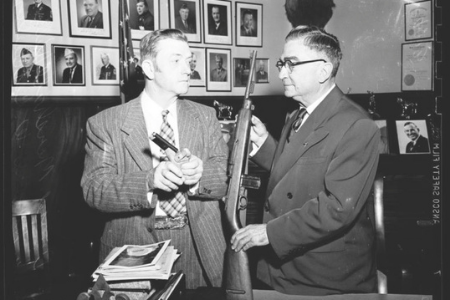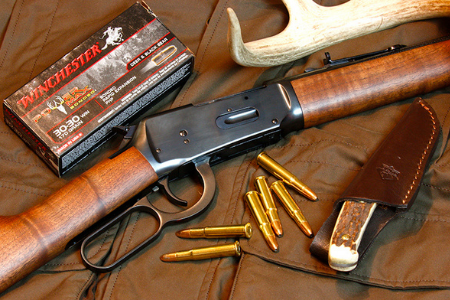If you are a student of WWII history or you are a WWII reenactor, you are familiar with the M1 Garand and the M1 Carbine. But contrary to what many people think, the M1 Carbine is not merely a smaller version of the M1 Garand.
Back in 1888, an American named Hiram Maxim, from Sangerville Maine, invented the machine gun, which was a true wonder of the age. It used the power of the bullet to extract and eject the empty brass casing, feed another bullet into the chamber, re-cock the hammer, and fire again as long as there was ammunition. Maxim’s model was able to fire 500 rounds per minute. All over the world, arms designers scrambled to adapt the auto-loading principle to rifles and pistols. Because of the low power of its small bullet, the pistol was relatively easy, and semi-automatic handguns began to appear five years later. The rifle, however, was much more difficult, because the power of the cartridge was so strong it usually broke the rifle after only a few shots.
The standard issue weapon for U.S. troops in WWI was the 1903 Springfield (“M1903”), which was a bolt action rifle that fired a .30-06 round. The gun was heavy to carry and slow to operate, because the shooter had to recycle the next round manually with the bolt. But it was accurate at long distances, which came in handy fighting in trench warfare. So after WWI ended in 1918, U.S. Ordnance began to search aggressively for an auto-loading infantry rifle. Over the next ten years, many inventors submitted designs for testing, but none proved acceptable. If they could stand up to the punishment, they were too heavy, and if they were light enough to be portable, they had to be in a small caliber.

One of the more promising designs was submitted by a young, Canadian-born inventor named John Cantius Garand. He was quickly employed by the main U.S. arms factory, Springfield Armory in Massachusetts, to develop his design further. Although promising, this rifle eventually reached a dead end, and the self-taught Garand set about on a new design. His new rifle derived the power to operate by tapping off the propellant gases of the fired bullet and using it to cycle the rifle. This design eventually beat out all the competition and was adopted as the standard U.S. infantry rifle in 1936. The rifle was simply called the “M1” (Model #1). The M1903 was retired from active service.
M1 Garand

The M1 Garand was subsequently one of the most advanced service rifles of the war. It was a semi-automatic rifle that utilized a gas operated and rotating bolt design that enabled it to reliably feed the large .30-06 Springfield rounds (marked as .30 caliber by the military), the same ammunition that had been used for the M1903. The rifle held eight rounds and fed via an enbloc clip loaded through the top of the receiver. It also weighed less than the M1903, but still heavy in its own right. Garand’s initial desire was to use a detachable magazine which fed from the bottom, but a man named John Peterson was working on his own semi-automatic rifle design in the 1920s at the Springfield Armory and convinced the Ordinance Department to go with the enbloc clip, as he felt it was better.
Nearly 5.5 million M1 Garands were built. They remained in service with the American military throughout the Korean War and into the late 1950s, until they were finally phased out and replaced with the M14 rifle (which itself was essentially an M1 re-chambered for 7.62x51mm NATO with a detachable box magazine and shorter gas cylinder) and later the M16.
M1 Carbine
The Army decided that a smaller and lighter weapon would be needed for support troops (such as radiomen or mortar men). While the shorter Thompson sub-machine gun was in use, it was heavier than a Garand when loaded. There was also the Colt M1911A1 (aka the “Colt 45”) pistol, but this obviously lacked range.
The M1 Carbine was developed after the M1 Garand and was a completely different weapon. While a good rifle, the Garand was also quite long and heavy.

The M1 Carbine was developed as a new weapon that would be lighter than both the Garand and the Thompson, while offering substantially superior firepower than the 1911. The new weapon was chambered for .30 carbine (not to be confused with the .30 caliber designation for the .30-06 Springfield of the Garand), which ballistically offered similar performance to the .357 Magnum. The standard magazine capacity was 15 rounds, compared to the Garand’s 8 rounds.
The new Carbine did borrow the rotating bolt design of the Garand, and it also made use of a shorter stroke piston that enabled better control for the shooter as well. The total weight of the M1 Carbine was just over five pounds, much less than the nearly ten pounds of the Garand.

The M1 Carbine found substantial favor with American troops, to the point that it was issued as a front line service weapon alongside the M1 Garand, the Thompson, and the Browning Automatic Rifle (aka “BAR”). Soldiers (and paratroopers especially), who adopted a variant called the M1A1 Carbine (with a folding stock) liked the M1 Carbine for its light weight, compact length, and semi-automatic firing capabilities.
Over six million M1 Carbines were built, the most of any American rifle produced during the war (even though the Garand remained the standard issue service rifle). The M1 Carbine continued to be used after the war and served alongside the M1 Garand again in the Korean War (where this time the Carbine was more commonly issued with an extended thirty round magazine).
M1 Carbines were also distributed to American allies during the Cold War conflicts; the South Vietnamese made extensive use of them in the Vietnam War, for instance.
Aside from their similar designations, the primary factor that these two vastly different platforms shared was the fact that they each served the United States well both during World War II and in later conflicts.
In conclusion, the M1 Garand was the standard issue American service rifle of World War II, while the M1 Carbine was a completely different weapon that was lighter, shorter, and fired a significantly smaller round.



